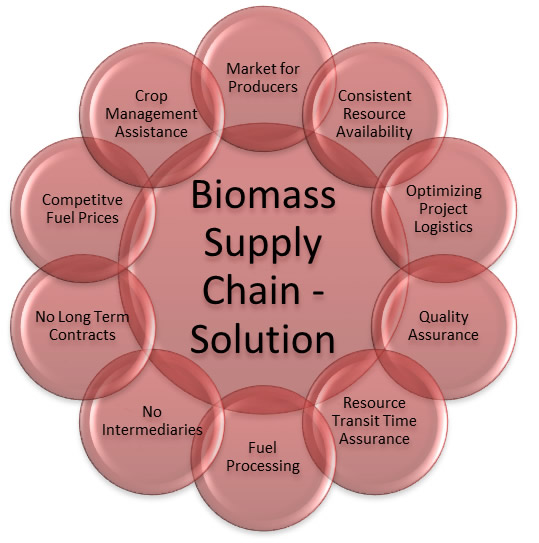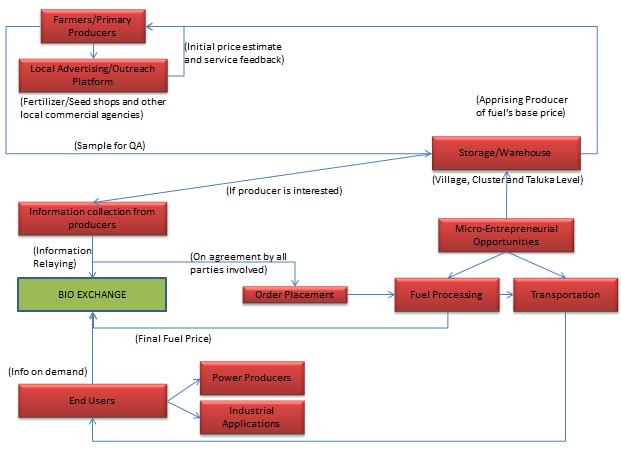In India alone, one can observe several cases where bio-energy projects of the scale greater than 5 MW are on sale already, even with their power purchase agreements still in place. Such events necessitate the need to have a mechanism in place which would further seek the promotion of such technologies.
Biomass Exchange - A Plug in the Missing Link
Setu Goyal
Introduction
Biomass resources have been in use for a variety of purposes since ages. Their multitude of uses includes usage as a livestock or for meeting domestic and industrial thermal requirements or for the generation of power to fulfill any electrical or mechanical needs. One of the major issues, however, associated with the use of any of biomass resources is its supply chain management. The resource being bulky, voluminous and only seasonally available produces serious hurdles in the reliable supply of the feedstock, regardless of its application.
The idea is thus to have something which plugs in this gap between the biomass resource availability and its demand.
The Problem
The supply chain management in any biomass based project is nothing less than a big management conundrum. The complexity deepens owing to the large number of stages which encompass the entire biomass value chain. It starts right from the resource harvesting and goes on to include the resource collection, processing, storage and eventually its transportation to the point of ultimate utilization.

Owing to the voluminous nature of the resource, its handling becomes a major issue since it requires bigger modes of logistics, employment of a larger number of work-force and a better storage infrastructure, as compared to any other fuel or feedstock.
.jpg) Not only this their lower energy density characteristic, makes it inevitable for the resource to be first processed and then utilized for power generation to make for better economics.
Not only this their lower energy density characteristic, makes it inevitable for the resource to be first processed and then utilized for power generation to make for better economics.All these hassles associated with such resources, magnify the issue of their utilization when it comes to their supply chain. The seasonal availability of most of the biomass resources, alternative application options, weather considerations, geographical conditions and numerous other parameters make it difficult for the resource to be made consistently available throughout the year.
This results in poor feedstock inputs at the utilization point which ends up generating energy in a highly erratic and unreliable manner.
The Solution
Although most of the problems discussed above, are issues inherently associated with the usage of biomass resources, they can be curtailed to a larger extent by strengthening the most important loophole in such projects – The Resource Supply Chain.
World over, major emphasis has been laid in researching upon the means to improve the efficiencies of such technologies. However, no significant due diligence has been carried out in fortifying the entire resource chain to assure such plants for a continuous resource supply.

The usual solution to encounter such a problem is to have long term contracts with the resource providers to not only have an assured supply but also guard the project against unrealistic escalations in the fuel costs. Although, this solution has been found to be viable, it becomes difficult to sustain such contracts for longer durations since these resources are also susceptible to numerous externalities which could be in the form of any natural disaster, infection from pests or any other socio-political or geographical disturbances, which eventually lead to an increased burden on the producers.
All these problems call for a mechanism to strengthen the value chain. This can be done by considering the following things:
- Assuring a readily available market for the resource providers or the producers
- Assuring the project developers of a reliable chain and consistent feedstock availability
- Awareness to the project developer of the resources in closest proximity to the plant site
- Assurance to the project developer of the resource quality
- Timely pick-up and drop of resource
- Proper fuel preparation as per technology requirements
- Removal of intermediaries involved in the process – to increase value for both, the producers as well as the buyers
- No need for long term contracts (Not an obligation)
- Competitive fuel prices
- Assistance to producers in crop management
The flow-chart below gives a general understanding of how such a model could work, especially in the context of developing nations where the size of land holdings is usually small and the location of resources is scattered, making their procurement a highly uneconomic affair.

In such a model, the seed, fertilizer shops and other local village level commercial enterprises could be utilized as an outreach or marketing platform for such a service. Once the producer approves off the initial price estimate, as provided by these agencies, he could send a sample of the feedstock to the pre-deputed warehouses for a quality check.
These warehouses need to be organized at different levels according to the village hierarchy and depending on the size, cultivated area and local logistic options available in that region. On assessing the feedstock sample’s quality, these centers would release a plausible quote to the farmer after approving which, he would be asked to supply the feedstock.
On the other hand, an entity in need of the feedstock would approach the exchange, where it would be apprised of the feedstock available in the region near its utilization point and made aware of the quantity and quality of the feedstock. The entity would then quote a price according to its suitability which would be relayed to the primary producer.
An agreement from both the sides would entail the placement of order and the feedstock’s subsequent processing and transportation to the buyer’s gate.
The pricing mechanisms could be numerous ranging from, fixed (according to quality), bid-based or even market-driven.
Roadblocks
The hurdles could be in the form of the initial resource assessment which could in itself be a tedious and time consuming exercise.
Another roadblock could be in the form of engaging the resource producers with such a mechanism. Since these would usually involve rural landscapes, things could prove to be a little difficult in terms of implementation of initial capacity building measures and concept marketing.
Benefits
The benefits of employing such a model are numerous as enumerated below:
- Support to the ever increasing power needs of the country
- Promotion of Bio-Energy Technologies
- Development of Rural Infrastructure
- Raised opportunities for Micro-Entrepreneurship
- Numerous direct and indirect job opportunities
- Efficient utilization of waste biomass resources
- Potential of averting Millions of tonnes of Green House Gas emissions
Conclusions
In India alone, one can observe several cases where bio-energy projects of the scale greater than 5 MW are on sale already, even with their power purchase agreements still in place. Such events necessitate the need to have a mechanism in place which would further seek the promotion of such technologies.
Biomass Exchange business comes up as a possible solution to this problem, at the same time providing the investors and entrepreneurs with a multi-million USD opportunity.
Although such a concept has been in existence in the developed world since ages now, it has not witnessed many entrepreneurial ventures with regards to developing nations where the need to strengthen the biomass supply chain becomes even more necessary. However, one needs to be really careful while initiating such a model since it cannot be blindly copied from the West owing to entirely different land-ownership patterns, regional socio-political conditions and economic framework.
With a strong backup and government support, such an idea could go a long way in the fortification of biomass supply chain, promotion of associated clean energy technologies and in making a significant dent in the present power scenario in the country.
References
- http://www.unep.fr/energy/activities/frm/pdf/BiomassPowerInsurance-FeasibilityStudy-Final.pdf
- https://www.mbioex.com/
- http://www.mnbiomassexchange.org/
- http://www.nabiomassexchange.com/
- http://nagpur.olx.in/8-mw-new-biomass-based-power-plant-for-sale-iid-174314137
- http://hyderabad.quikr.com/BIO-MASS-POWER-PLANTS-FOR-SALE-W0QQAdIdZ64399383
- http://tuffclassified.com/8-5-mw-biomass-power-plant-in-india-for-sale-with-all-assets-and-land-lisences-agreements-clearances/
- http://bhopal.quikr.com/7-5MW-Biomass-Power-Plant-for-sale-in-Rajnandgaon-W0QQAdIdZ71611850
About the Author
Setu Goyal is pursuing Masters Program in Renewable Energy Engineering and Management at the TERI University (New Delhi), and has an entrepreneurial zeal to improve waste management and renewable energy scenarios in developing countries. He can be reached at setu.goyal@gmail.com
The content & opinions in this article are the author’s and do not necessarily represent the views of AltEnergyMag
Comments (0)
This post does not have any comments. Be the first to leave a comment below.
Featured Product

MORNINGSTAR - ReadyEdge
The ReadyEdgeTM (RE-1) accessory is an intelligent system controlling and reporting device meant to make monitoring your solar energy system more transparent. Enabling access to LiveViewTM 2.0 and Morningstar Solar ConnectTM, ReadyEdge provides data from all compatible Morningstar devices in your system. It is designed to be paired with the three ReadyBlock options, up to six total, with the possibility to use multiple ReadyShunts and ReadyRelays. The ReadyEdge is compatible with select Morningstar products.
